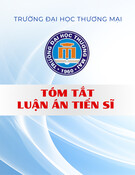INTERNET MARKETING STRATEGY
• WHAT • WHY • WHERE WE ARE, WHAT WE WANT
AND HOW TO GET THERE
• FRAMEWORK • INFLUENCES • CSF’S • P’S • IMPLEMENTATION ISSUES
• WHY ON LINE? • ADDED VALUE FOR BUSINESS /
CUSTOMERS
• CONSEQUENCES FOR THE BUSINESS
in module 12:
ADDED VALUE (COMPANY) Main value factors: 1. Market attractiveness -> new product market combinations 2. Extending sales proposition -> focus on competitiveness / RELATIONSHIPS 3. Recourse exploitation i.e. extensive catalogues, (B-B) ordering on line -> cost cutting 4. Combinations / other factors FRAMEWORK: •Company strategy => •E-commerce strategy => •I-marketing strategy => •Define Internet marketing plan => •Design site / create web shop =>•Implement site => •Monitor (metrics) => •Review and modify
VISION MISSION GOALS ENVIRONMENT ANALYSIS (INT. & EXT.) ES TEST 1. Product characteristics: Does the product need to be physically tried or touched, before it is bought? 2. Familiarity and confidence: The degree to which consumer recognizes and trusts the product and brand 3. Consumer attributes: fits the electronic buyer behavior with the product? (I.e. target group) VISION •Dream: Vision and mission •Think: Strategic analysis •Dare: Strategic choices •Do: Implementation / review
Phase 1: Goal setting 1. Vision / Mission 2. Corporate objectives Phase 2: Situation review 3. Marketing audit 4. SWOT analysis Phase 3 Strategy formulation 5. Assumptions 6. Marketing objectives and strategies (4 p‘s) 7. Estimate expected results 8. Identify alternative plans and mixes Phase 4 Resource allocation, implementing and monitoring 9. Budget 10. Detailed implementation program Phase 5 Measurement and review (5 p’s: proper preparation prevents poor performance)
CRITICAL SUCCESS FACTORS: • Unique products or services • Management support • Project team reflecting various functional areas (integration)
• Technical infrastructure • Customer acceptance/ User friendly • Integration with the corporate legacy
systems
• Security and control of the EC system • Competition and market situation • Pilot project and corporate knowledge • Promotion and internal
communication • Cost of the project • Level of trust between buyers and
sellers
SWOT (SLIDE 42)
(cid:214) STRATEGIES
STRATEGIC DECISIONS Decide on items such as: •Product / service diversification •Information easier to find •Advertising and sponsorships •Brochureware (up-to-date) •Lead generation / traffic building •Relationship-building (personalize communications 1:1) •Branding and corporate image building •Customer magnet strategy •Syndicated selling •Gaining internal efficiencies •how and what
P-ISSUES: PRODUCT: POSITIONING AND DIFFERENTATION! COMPETITIVE ADVANTAGE: sustainable? –Online presentation of product (3d?) / info –Different brands online –Personalised services to build relationships –Value added services: order tracking, - wrapping service, bill printing, etc. PRICE:
• TRANSPARENCY • PRECISION PRICING • BASED ON STAGE IN PLC: • PENETRATION • SKIMMING • PSYCHOLOGICAL • PRICE LEADERSHIP • PROMOTIONAL PRICING
PLACE:
• WEB SITE AS ONLY CHANNEL? • HOW TO AVOID CONFLICTS • EXPORT REGULATIONS / LEGAL
ASPECTS
• EASIER INTERACTION • NEW CHANNEL FOR MAKING
CONTACTS
• DISTRIBUTION COSTS OF DIGITALIZED PRODUCTS
PROMOTION:
• HIGH COSTS! • OFF LINE VS ON LINE • TRAFFIC GENERATION • RETURN RATE • STICKEYNESS • DIRECT RESPNSE AFTER CLICKING
ON BANNER
WHY RETURN?? 1 High quality content 75% 2 Ease of use 66% 3 Quick to download 58% 4 Updated frequently 54% 5 Coupons and incentives 14% 6 Favorite brands 13% 7 Cutting edge technology 12% 8 Games 12% 9 Purchasing capabilities 11% 10 Customizable content 10% 1998 Forrester Research poll of 8,600 online households WEB SITE SUCCESS FACTORS: Success factors: •way of delivery info / selection / search •interaction /NAVIGATING •Customization of pages and (physical) products => advice •quote quality •networking / community (clients) •ubiquity (delivery) •agreement (trust) / privacy
preparation for implementation
• Re-evaluate (distribution and supply)
value chain models (delivering!)
• Conduct necessary education training • Stay aware of what your customers and partners expect from you and your site • Re-evaluate the nature of your business,
organization, products and services
• Give a new role to your human resources department (ICT, Legal, Logistics dept.)
IMPLEMENTATION: SITE ·Reflects consistent business purpose: ·Goal of the website must be clear ·Reason for generating traffic (service?) ·Who is the target audience being sought? ·How will viewers access site? ·Viewer: answers within a few mouse clicks - easy linking to products & info ·Speed and ease of use must be a high priority ·What are logical (product) categories? ·Are there design considerations? ·What are the content considerations ·What about (automated) updating the site? ·How to manage navigation and consistent look and feel issues? ACTIVITY: WHAT TO OUTSOURCE? (SLIDE 81)
capabilities / feedback
responsibilities
Critical issues regarding implementation: - Who ‘owns’ the process? - Who owns the content? - Who owns the format? - Who decides on customer service - Structure of the site - Who owns the technology? => appointments about ACTIVITY: SLIDE 94




































